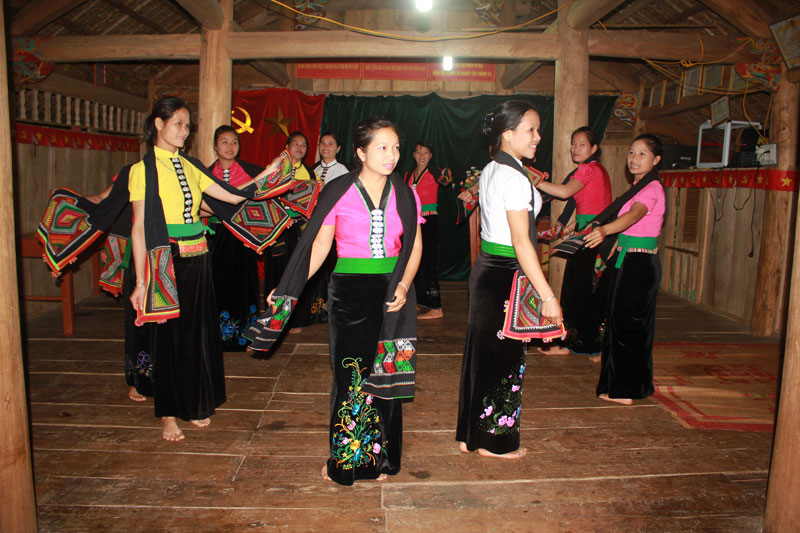
(HBO) – Tay ethnic people account for 40.57 percent of the population in Da Bac district, which is home to five ethnic groups. They reside in the communes of Muong Chieng, Dong Chum, Tan Pheo, Tan Minh and Trung Thanh.
We felt the atmosphere of the National Day when
returning to Muong Chieng, which has the biggest number of
Tayethnics and is described as the "mountainous centre” of Da Bac district. The
National Day September 2 was an occasion for those living far away to reunite
with their families. Sa Van Xuyen, a resident in Na Muoi hamlet, said: "My
family has three children, including two daughters working here and a son
working in
Son La.All of them have their own families. My son, Hung, and his wife have to live
far away because Hung has his own work while his wife is studying at
Tay
Bac
University. Only on the
occasion of major festivals my whole family reunite. My wife and I are waiting
to see them on the upcoming National Day or Independence Festival.”

Xa Van
Bang, a resident in Chieng Can hamlet of Muong Chieng commune (Da Bac), often
hold a ritual called "Lam cham” for his family according to Tay people’s
traditional custom after the Independence Festival celebration.
Bidding farewell to Xuyen, we came to Chieng Can
commune to visit Xa Van Hoi, who was a driver in the southern battlefield for
13 years (from 1970 to 1983). Recalling wartime memories, Hoi said: "The 13
years I was a driver at Unit 670 of Regiment 19 were also 13 times I spent the National
Day with my comrades and witnessed both pains and victories in the war. I still
remember the feeling of concurrently celebrating Tet (the traditional New Year
festival), standing guard and being ready to fight. It was not rare that I saw
my comrades were killed by the enemy’s bullets and bombs. Those pains nurtured
our undaunted and unyielding will, helping us fight for national independence.”
The team
of Na Man hamlet, Muong Chieng commune (Da Bac), rehearses a singing and
dancing performance imbued with the
Tayculture before the celebration of the National Day September 2.
His children usually come home twice a year, on
the National Day (September 2) and the Lunar New Year. Hoi said: "Whenever the
Independence Festival comes, I’m eager for my children to come back to reunite
with the family. To me, seeing my children gradually growing up each time we
gather is the most joyful festival.”
Singing and dancing performances and sports
activities like volleyball and football matches between hamlets, and communes
on the occasion of the Independence Festival were always magnets for local
residents.
We also witnessed
Tayethnic girls’ dedication to a rehearsal before their public performance marking
the National Day in Na Man hamlet of Muong Chieng commune. Xa Thi Thay, who led
the hamlet’s performing team, said they were rehearsing a "xoe” dance which
would be performed together with other teams in the commune. We chose this
dance since it was deeply imbued with the
Tayethnic group’s cultural identities, showing the community’s solidarity and
love.
Aside from entertainment activities, the "Lam
cham” ritual of
Tay people was also practiced
by many families in the Independence Festival. Xa Van Bang, a resident in
Chieng Can commune, said the ritual was often organised in the eighth or ninth
lunar months, but now some families hold this ritual on the September 2
occasion, when their whole families reunited.
The emulation movement "Hoa Binh joining hands to build new-style rural areas” has been widely spreading, becoming a driving force that motivates the localities to renew rural landscapes and improve the material and spiritual lives of the residents. In this movement, the people play a central role-both as the main implementers and direct beneficiaries of its outcomes.
In response to the global digital revolution, Hoa Binh Newspaper is transforming itself into a modern and multi-platform media hub, blending cutting-edge technology with a restructured newsroom and a new generation of tech-savvy journalists.
Hoa Binh province’s Association of the Elderly recently held a conference to review the project on expanding the inter-generation self-help club model until 2025.
In a move to implement Resolution No. 57-NQ/TW, issued on December 22, 2024 by the Politburo, which targets breakthroughs in science-technology development, innovation, and digital transformation, the Hoa Binh provincial Department of Health has issued a plan to roll out the "Digital Literacy for All” campaign within the local health sector.
An Nghia Commune (Lạc Sơn District) is one of the communes that achieved the tha standard of the national new rural area in 2018. Entering a new development phase, the commune is now trying to meet the criteria for the advanced new rural development. With the strong political will and the public consensus, the commune is gradually overcoming the challenges to reach this goal, aiming for the sustainable development.




